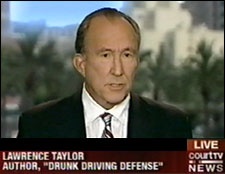California DUI with a High BAC
Friday, September 29th, 2017Many people know that the legal blood alcohol content limit is 0.08 percent and that if caught driving with a 0.08 percent or more, they will face the penalties associated with a DUI. Few people however know that if they are caught driving with a blood alcohol content that is much higher than the legal limit, they face additional penalties.
The mandatory minimum punishment for a first time DUI conviction in California is $390 plus penalties and assessments, which are like court taxes and will increase the overall amount to about $2,000, three years of summary (informal) probation, and a three-month DUI program called AB-541.
The first consequence of a driver having a high blood alcohol content, beyond the mandatory minimum penalties mentioned above, is that they must admit to having a high blood alcohol content. The prosecutor may include in the criminal complaint a “special allegation” that the driver’s blood alcohol content was high. In addition to pleading guilty to the DUI itself, as part of a plea deal, prosecutors often want the driver to admit on the record that the special allegation that their blood alcohol content was particularly high.
A driver may also be facing a longer DUI program. AB 762 is a six-month program and AB 1353 is a nine-month program and both can be offered as part of plea deal for an elevated blood alcohol content. There is an 18-month program called SB 38, but it is reserved for people who have been convicted of one or more California DUI’s within the past 10 years.
Another additional penalty that a person faces after a California DUI conviction with a high blood alcohol content is the Mothers Against Drunk Driving Victim Impact Panel. According to Mother Against Drunk Driving (MADD), one of their main goals is to prevent recidivism of DUI offenses. In an attempt to accomplish this, MADD provides one-day presentations where convicted DUI offenders listen to the stories of people whose lives have been negatively affected by drunk driving. The speakers are usually victims of DUI-related collisions or relatives of those who were killed as the result of DUI-related collisions.
The prosecutor might also offer a Hospital and Morgue (HAM) program. The name is exactly what the program entails. The person convicted of the California DUI must visit with doctors at a hospital who address the dangers of driving drunk and experience the health consequences of driving drunk. Following the hospital visit, the person must visit a morgue where they view the bodies that are stored there and are confronted with the ultimate consequence of driving drunk and other risky behavior. After both the hospital and morgue components are completed, the person must write an essay reflecting on their experience, the lessons learned, and behavior moving forward.
Alcoholics Anonymous (AA) meetings might also be offered as an additional penalty when a BAC is particularly high. According to its own website, www.aa.org, “AA is an international fellowship of men and women who have a drinking problem…Membership is open to anyone who wants to do something about his or her drinking problem.” AA meetings are relatively easy to locate and are offered throughout the week at varying times. Since the meetings only typically last one hour to 90 minutes, the court usually requires at least 10 meetings. For extremely high BAC readings, a person may have to a significant amount of AA meetings.
Lastly, a person may actually have to serve jail time. Whether a prosecutor will want jail for an elevated BAC depends other aggravating factors surrounding the DUI, the county in which the DUI took place, and the courthouse itself. Although it is the most severe of the increased penalties and unlikely to be offered, it is possible.
A driver with a particularly high blood alcohol content may face one, all, or a combination of any of the abovementioned increased penalties. Other, less frequent penalties, such as a SCRAM device or an ignition interlock device, may also be included. Since these penalties are not mandatory, it is important to hire a California DUI attorney to possibly eliminate them as part of a DUI sentence.



